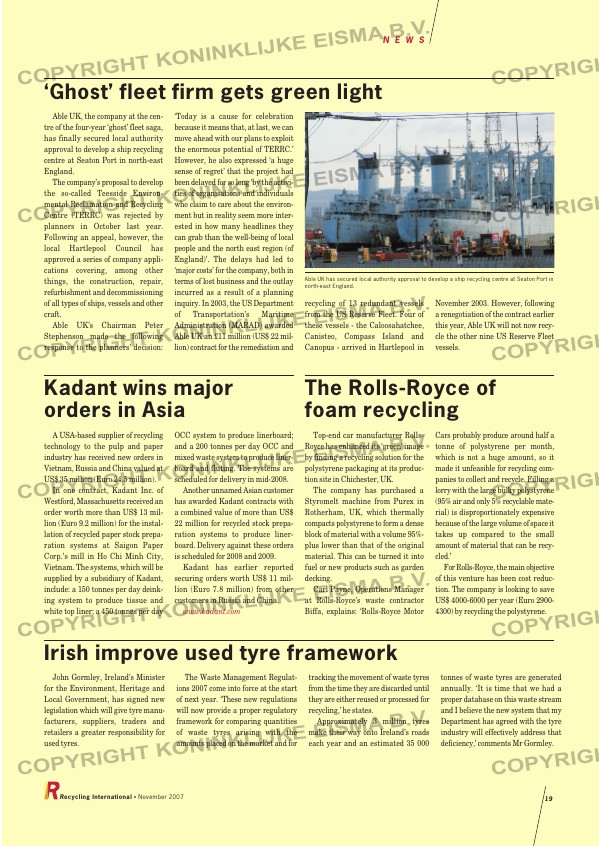Page 19 from: November 2007

N E W S
‘Ghost’ fleet firm gets green light
Able UK, the company at the cen-
tre of the four-year ‘ghost’ fleet saga,
has finally secured local authority
approval to develop a ship recycling
centre at Seaton Port in north-east
England.
The company’s proposal to develop
the so-called Teesside Environ –
mental Reclamation and Recycling
Centre (TERRC) was rejected by
planners in October last year.
Following an appeal, however, the
local Hartlepool Council has
approved a series of company appli-
cations covering, among other
things, the construction, repair,
refurbishment and decommissioning
of all types of ships, vessels and other
craft.
Able UK’s Chairman Peter
Stephenson made the following
response to the planners’ decision:
‘Today is a cause for celebration
because it means that, at last, we can
move ahead with our plans to exploit
the enormous potential of TERRC.’
However, he also expressed ‘a huge
sense of regret’ that the project had
been delayed for so long ‘by the activi-
ties of organisations and individuals
who claim to care about the environ-
ment but in reality seem more inter-
ested in how many headlines they
can grab than the well-being of local
people and the north east region (of
England)’. The delays had led to
‘major costs’ for the company, both in
terms of lost business and the outlay
incurred as a result of a planning
inquiry. In 2003, the US Department
of Transportation’s Maritime
Adminis trat ion (MARAD) awarded
Able UK an £11 million (US$ 22 mil-
lion) contract for the remediation and
recycling of 13 redundant vessels
from the US Reserve Fleet. Four of
these vessels – the Caloosahatchee,
Canisteo, Compass Island and
Canopus – arrived in Hartlepool in
November 2003. However, following
a renegotiation of the contract earlier
this year, Able UK will not now recy-
cle the other nine US Reserve Fleet
vessels.
John Gormley, Ireland’s Minister
for the Environment, Heritage and
Local Government, has signed new
legislation which will give tyre manu-
facturers, suppliers, traders and
retailers a greater responsibility for
used tyres.
The Waste Management Regulat –
ions 2007 come into force at the start
of next year. ‘These new regulations
will now provide a proper regulatory
framework for comparing quantities
of waste tyres arising with the
amounts placed on the market and for
tracking the movement of waste tyres
from the time they are discarded until
they are either reused or processed for
recycling,’ he states.
Approximately 3 million tyres
make their way onto Ireland’s roads
each year and an estimated 35 000
tonnes of waste tyres are generated
annually. ‘It is time that we had a
proper database on this waste stream
and I believe the new system that my
Department has agreed with the tyre
industry will effectively address that
deficiency,’ comments Mr Gormley.
Recycling International • November 2007 19
Irish improve used tyre framework
Kadant wins major
orders in Asia
A USA-based supplier of recycling
technology to the pulp and paper
industry has received new orders in
Vietnam, Russia and China valued at
US$ 35 million (Euro 24.5 million).
In one contract, Kadant Inc. of
Westford, Massachusetts received an
order worth more than US$ 13 mil-
lion (Euro 9.2 million) for the instal-
lation of recycled paper stock prepa-
ration systems at Saigon Paper
Corp.’s mill in Ho Chi Minh City,
Vietnam. The systems, which will be
supplied by a subsidiary of Kadant,
include: a 150 tonnes per day deink-
ing system to produce tissue and
white top liner; a 450 tonnes per day
OCC system to produce linerboard;
and a 200 tonnes per day OCC and
mixed waste system to produce liner-
board and fluting. The systems are
scheduled for delivery in mid-2008.
Another unnamed Asian customer
has awarded Kadant contracts with
a combined value of more than US$
22 million for recycled stock prepa-
ration systems to produce liner-
board. Delivery against these orders
is scheduled for 2008 and 2009.
Kadant has earlier reported
securing orders worth US$ 11 mil-
lion (Euro 7.8 million) from other
customers in Russia and China.
www.kadant.com
The Rolls-Royce of
foam recycling
Top-end car manufacturer Rolls-
Royce has enhanced its ‘green’ image
by finding a recycling solution for the
polystyrene packaging at its produc-
tion site in Chichester, UK.
The company has purchased a
Styromelt machine from Purex in
Rotherham, UK, which thermally
compacts polystyrene to form a dense
block of material with a volume 95%-
plus lower than that of the original
material. This can be turned it into
fuel or new products such as garden
decking.
Carl Payne, Operations Manager
at Rolls-Royce’s waste contractor
Biffa, explains: ‘Rolls-Royce Motor
Cars probably produce around half a
tonne of polystyrene per month,
which is not a huge amount, so it
made it unfeasible for recycling com-
panies to collect and recycle. Filling a
lorry with the large bulky polystyrene
(95% air and only 5% recyclable mate-
rial) is disproportionately expensive
because of the large volume of space it
takes up compared to the small
amount of material that can be recy-
cled.’
For Rolls-Royce, the main objective
of this venture has been cost reduc-
tion. The company is looking to save
US$ 4000-6000 per year (Euro 2900-
4300) by recycling the polystyrene.
Able UK has secured local authority approval to develop a ship recycling centre at Seaton Port in
north-east England.
RI_023 News:Opmaak 1 08-11-2007 09:12 Pagina 19



